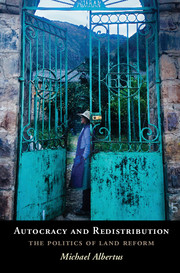Book contents
- Frontmatter
- Contents
- List of Tables
- List of Figures
- Acknowledgments
- 1 Introduction
- 2 Actors, Interests, and the Origins of Elite Splits
- 3 A Theory of Land Reform
- 4 Measuring Land Reform
- 5 A Cross-National Analysis of Land Reform in Latin America
- 6 Elite Splits and Redistribution under Autocracy: Peru's “Revolution from Above”
- 7 Land Reform Transformed to Redistribution: Venezuela's Punto Fijo Democracy and Chávez's Bolivarian Revolution
- 8 Latin America in Comparative Perspective
- 9 Conclusion
- References
- Index
- Other Books in the Series
5 - A Cross-National Analysis of Land Reform in Latin America
Published online by Cambridge University Press: 05 October 2015
- Frontmatter
- Contents
- List of Tables
- List of Figures
- Acknowledgments
- 1 Introduction
- 2 Actors, Interests, and the Origins of Elite Splits
- 3 A Theory of Land Reform
- 4 Measuring Land Reform
- 5 A Cross-National Analysis of Land Reform in Latin America
- 6 Elite Splits and Redistribution under Autocracy: Peru's “Revolution from Above”
- 7 Land Reform Transformed to Redistribution: Venezuela's Punto Fijo Democracy and Chávez's Bolivarian Revolution
- 8 Latin America in Comparative Perspective
- 9 Conclusion
- References
- Index
- Other Books in the Series
Summary
The theory and propositions in Chapter 3 anticipate land redistribution when two key circumstances are met: a coalitional split between ruling political elites and landed elites and low institutional barriers to reform. Rural pressure should also increase the likelihood of land redistribution. This chapter employs the data and coding scheme developed in Chapter 4 to empirically test this argument.
Land redistribution first requires a significant coalitional split between landed elites and ruling political elites. Ruling political elites will be motivated to target landed elites for redistribution when there is low coalitional overlap between these groups. The political elite's expropriation of landed elites in this case can preserve their ability to act independently in the future by eliminating powerful, potentially threatening rivals. The political elite's support coalition, which may harbor uncertainty about the intentions of the political elite, also benefits from this policy when its members are distinct from the landed elite. Redistribution away from current landed elites – even if land is not redistributed to the support coalition itself – reveals that ruling political elites favor the political support of the coalition that brought them to office over the support of landed elites. A political elite that fails to redistribute in these circumstances will therefore either be ousted or voted out by its support coalition, or it will pay steep costs to insulate itself from an internal coup. Conversely, political elites have few incentives to redistribute land when their coalition contains landed elites. Doing so would risk their political fate by upending the stability of their own governing coalition.
A coalitional divergence between ruling political elites and landed elites, however, is insufficient to yield land redistribution. Institutional constraints to policymaking must also be low enough to enable political elites to act decisively. Land reform efforts often fail when the executive opposes reform, the legislature cuts off funding, the bureaucracy is captured by landed elites, or the judiciary strikes down the constitutionality of property redistribution. Lower institutional constraints therefore increase the likelihood that land redistribution can be successfully implemented when the interests of political elites and landed elites diverge. This is most typically found under autocracy. Among democracies, majoritarian forms of democracy with fewer veto points face fewer institutional constraints to redistribution and therefore are more likely to redistribute than democracies that are characterized by heavy checks and balances.
- Type
- Chapter
- Information
- Autocracy and RedistributionThe Politics of Land Reform, pp. 142 - 189Publisher: Cambridge University PressPrint publication year: 2015

